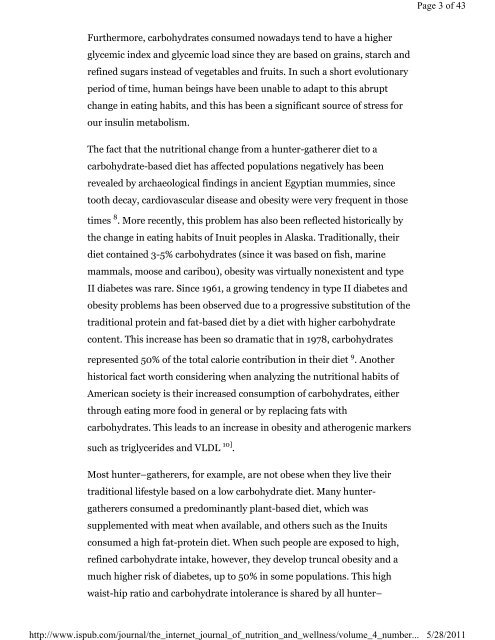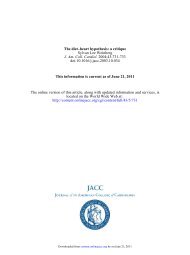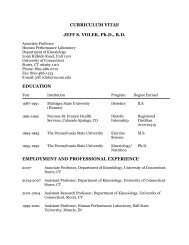Arguments in favor of ketogenic diets - Nutrition and Metabolism ...
Arguments in favor of ketogenic diets - Nutrition and Metabolism ...
Arguments in favor of ketogenic diets - Nutrition and Metabolism ...
You also want an ePaper? Increase the reach of your titles
YUMPU automatically turns print PDFs into web optimized ePapers that Google loves.
http://www.ispub.com/journal/the_<strong>in</strong>ternet_journal_<strong>of</strong>_nutrition_<strong>and</strong>_wellness/volume_4_number...Page 3 <strong>of</strong> 435/28/2011Furthermore, carbohydrates consumed nowadays tend to have a higherglycemic <strong>in</strong>dex <strong>and</strong> glycemic load s<strong>in</strong>ce they are based on gra<strong>in</strong>s, starch <strong>and</strong>ref<strong>in</strong>ed sugars <strong>in</strong>stead <strong>of</strong> vegetables <strong>and</strong> fruits. In such a short evolutionaryperiod <strong>of</strong> time, human be<strong>in</strong>gs have been unable to adapt to this abruptchange <strong>in</strong> eat<strong>in</strong>g habits, <strong>and</strong> this has been a significant source <strong>of</strong> stress forour <strong>in</strong>sul<strong>in</strong> metabolism.The fact that the nutritional change from a hunter-gatherer diet to acarbohydrate-based diet has affected populations negatively has beenrevealed by archaeological f<strong>in</strong>d<strong>in</strong>gs <strong>in</strong> ancient Egyptian mummies, s<strong>in</strong>cetooth decay, cardiovascular disease <strong>and</strong> obesity were very frequent <strong>in</strong> thosetimes 8 . More recently, this problem has also been reflected historically bythe change <strong>in</strong> eat<strong>in</strong>g habits <strong>of</strong> Inuit peoples <strong>in</strong> Alaska. Traditionally, theirdiet conta<strong>in</strong>ed 3-5% carbohydrates (s<strong>in</strong>ce it was based on fish, mar<strong>in</strong>emammals, moose <strong>and</strong> caribou), obesity was virtually nonexistent <strong>and</strong> typeII diabetes was rare. S<strong>in</strong>ce 1961, a grow<strong>in</strong>g tendency <strong>in</strong> type II diabetes <strong>and</strong>obesity problems has been observed due to a progressive substitution <strong>of</strong> thetraditional prote<strong>in</strong> <strong>and</strong> fat-based diet by a diet with higher carbohydratecontent. This <strong>in</strong>crease has been so dramatic that <strong>in</strong> 1978, carbohydratesrepresented 50% <strong>of</strong> the total calorie contribution <strong>in</strong> their diet 9 . Anotherhistorical fact worth consider<strong>in</strong>g when analyz<strong>in</strong>g the nutritional habits <strong>of</strong>American society is their <strong>in</strong>creased consumption <strong>of</strong> carbohydrates, eitherthrough eat<strong>in</strong>g more food <strong>in</strong> general or by replac<strong>in</strong>g fats withcarbohydrates. This leads to an <strong>in</strong>crease <strong>in</strong> obesity <strong>and</strong> atherogenic markerssuch as triglycerides <strong>and</strong> VLDL 10] .Most hunter–gatherers, for example, are not obese when they live theirtraditional lifestyle based on a low carbohydrate diet. Many huntergatherersconsumed a predom<strong>in</strong>antly plant-based diet, which wassupplemented with meat when available, <strong>and</strong> others such as the Inuitsconsumed a high fat-prote<strong>in</strong> diet. When such people are exposed to high,ref<strong>in</strong>ed carbohydrate <strong>in</strong>take, however, they develop truncal obesity <strong>and</strong> amuch higher risk <strong>of</strong> diabetes, up to 50% <strong>in</strong> some populations. This highwaist-hip ratio <strong>and</strong> carbohydrate <strong>in</strong>tolerance is shared by all hunter–






